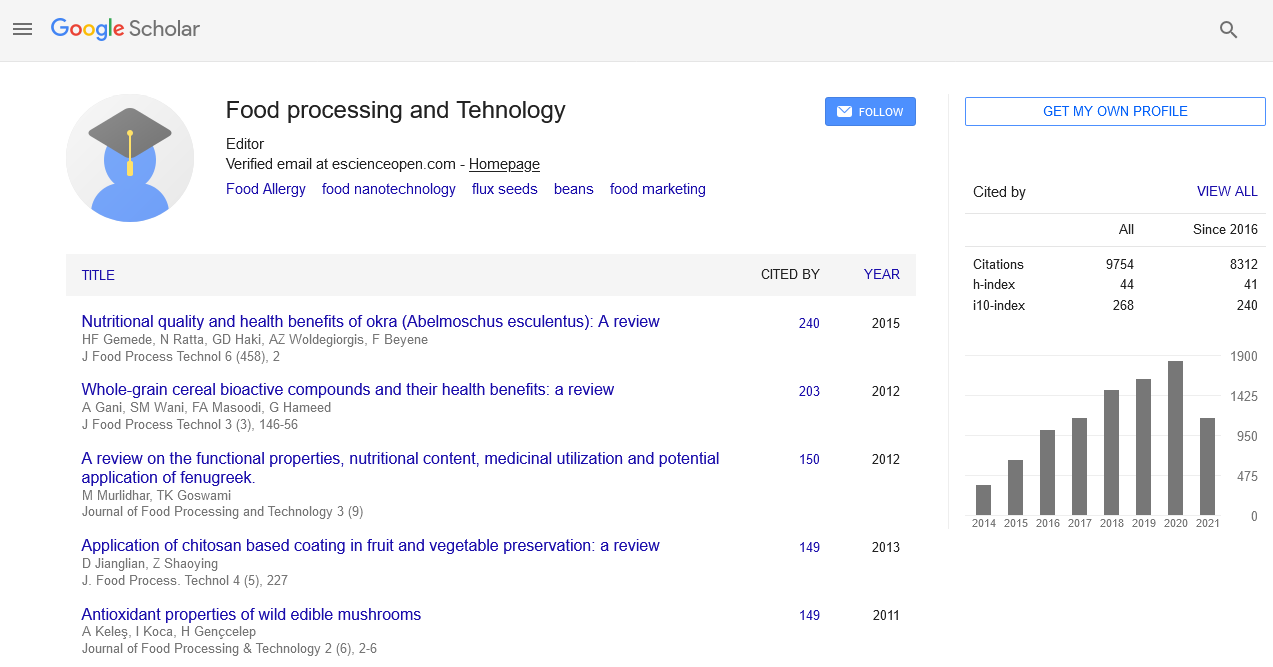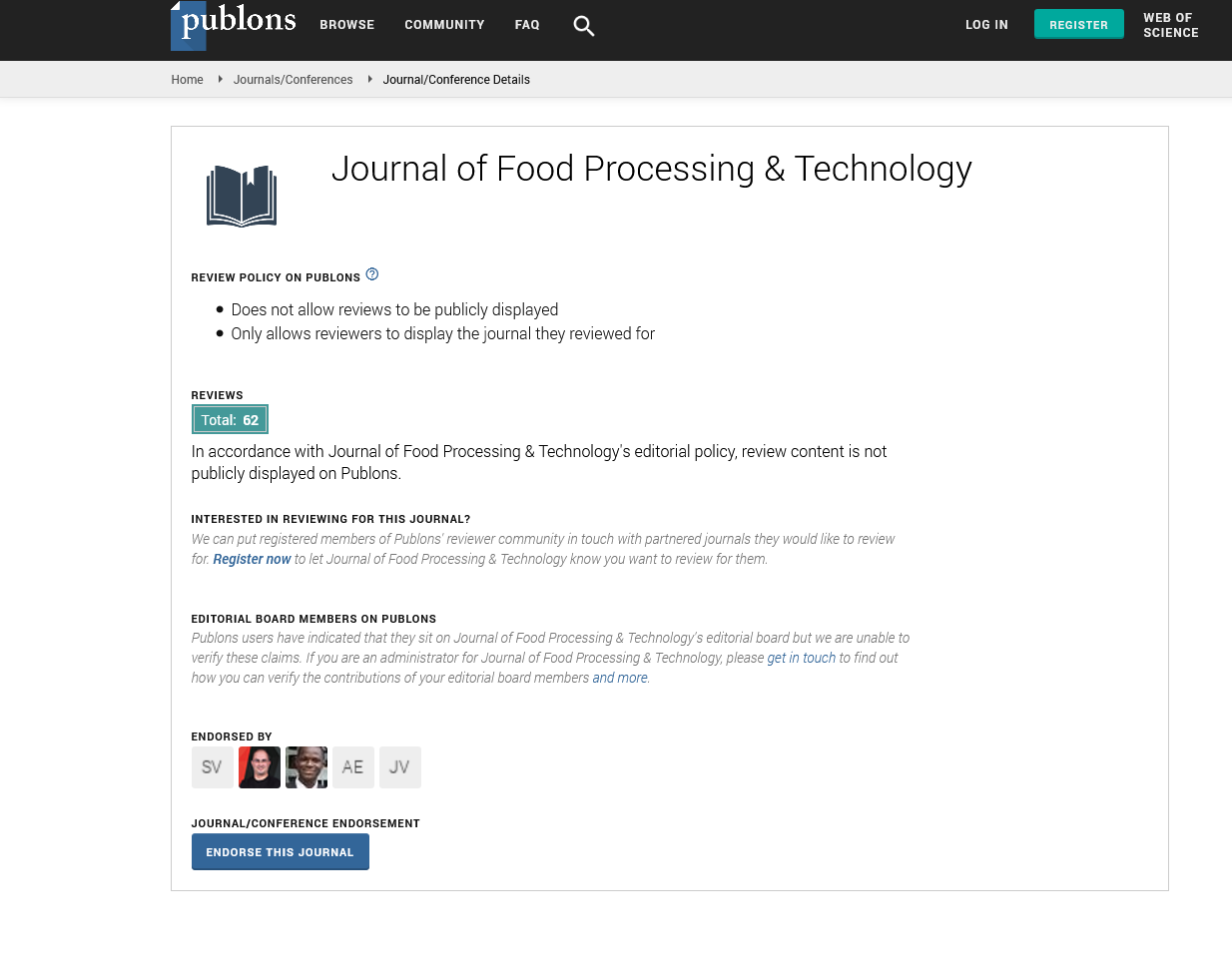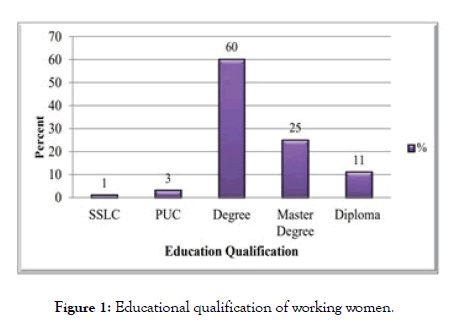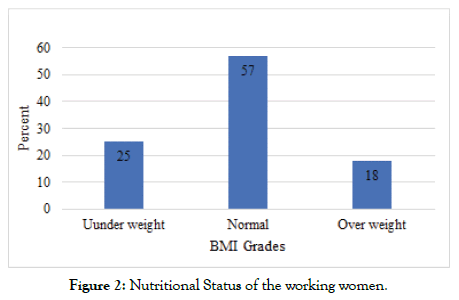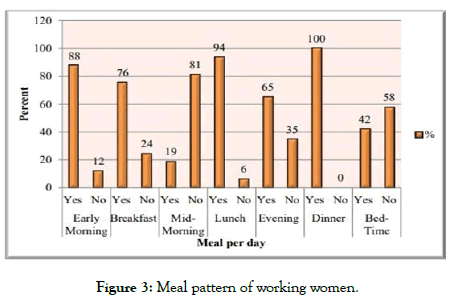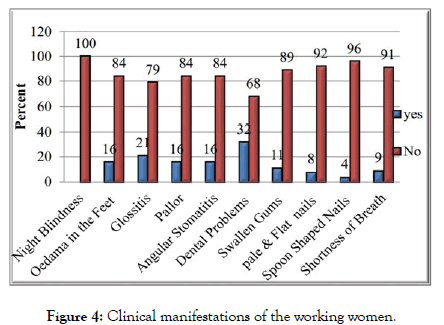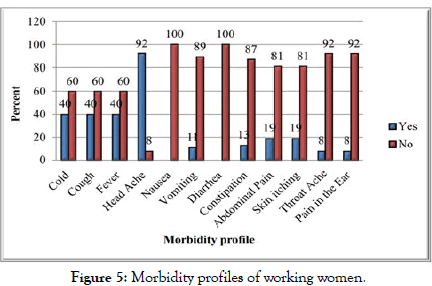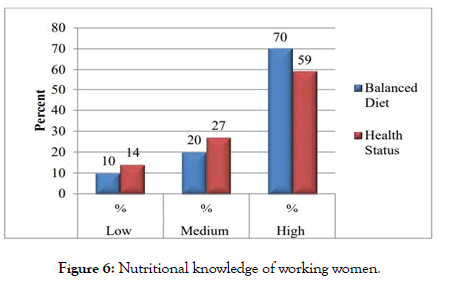Indexed In
- Genamics JournalSeek
- Academic Keys
- JournalTOCs
- China National Knowledge Infrastructure (CNKI)
- Access to Global Online Research in Agriculture (AGORA)
- Centre for Agriculture and Biosciences International (CABI)
- RefSeek
- Directory of Research Journal Indexing (DRJI)
- Hamdard University
- EBSCO A-Z
- OCLC- WorldCat
- Scholarsteer
- SWB online catalog
- Publons
- Euro Pub
- Google Scholar
Useful Links
Share This Page
Journal Flyer
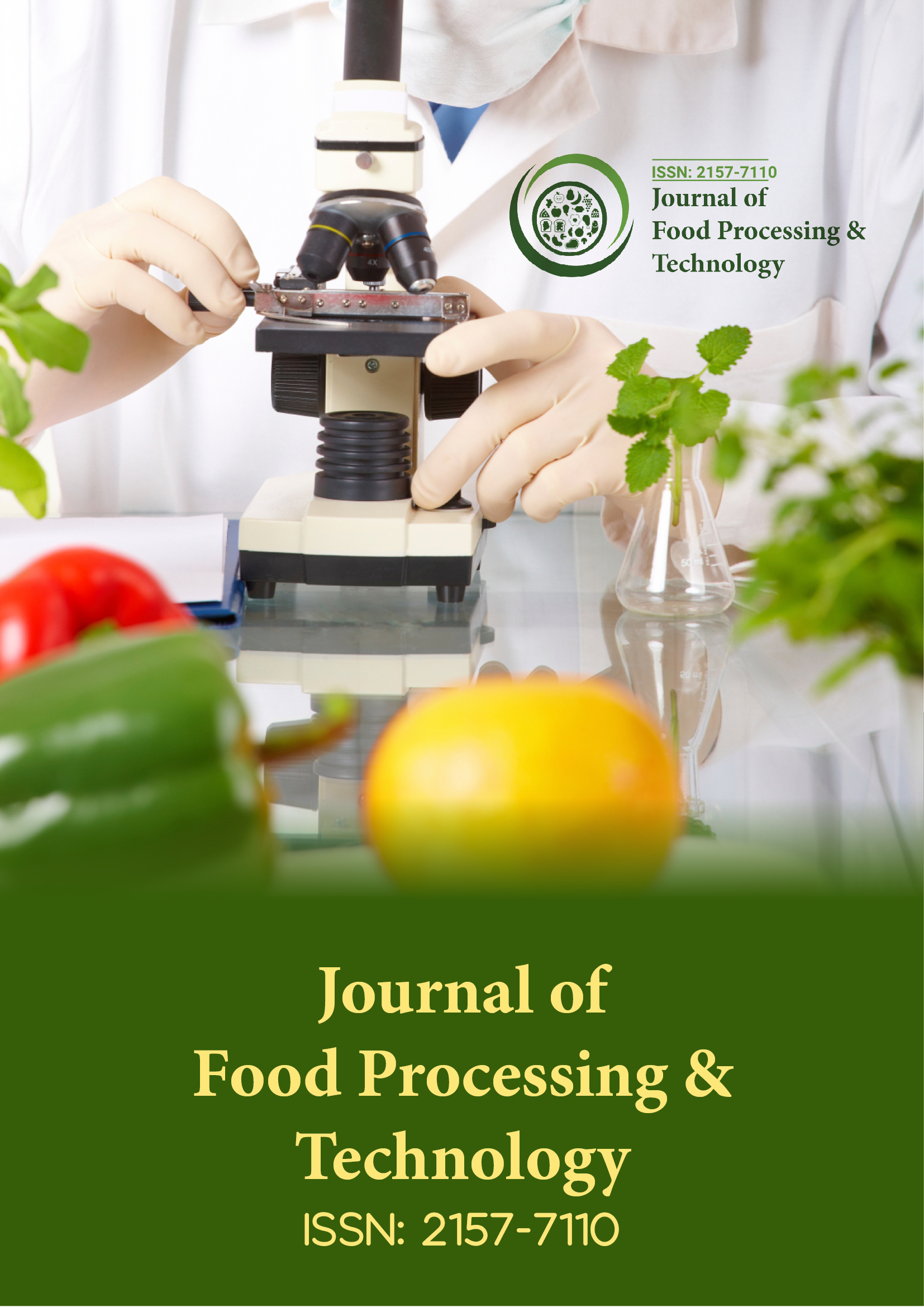
Open Access Journals
- Agri and Aquaculture
- Biochemistry
- Bioinformatics & Systems Biology
- Business & Management
- Chemistry
- Clinical Sciences
- Engineering
- Food & Nutrition
- General Science
- Genetics & Molecular Biology
- Immunology & Microbiology
- Medical Sciences
- Neuroscience & Psychology
- Nursing & Health Care
- Pharmaceutical Sciences
Research Article - (2020) Volume 11, Issue 8
A Study on Assessment of Nutritional Status and Nutritional Knowledge of Working Women Residing in Hostels at Mysuru City
Rachappa Pallavi, Ranganath Deepa and Chandrashekar Sudharma Devaki*Received: 26-Jul-2020 Published: 24-Aug-2020, DOI: 10.35248/2157-7110.20.11.841
Abstract
The present study was conducted to assess the nutritional status and nutritional knowledge of working women residing in hostels at Mysore city. In the present study, 150 members of women staying in four different hostels were selected for the study and they were assessed for the nutritional status and nutritional knowledge. The nutritional status was assessed with the help of their dietary intake using 24 hours recall method, anthropometry measurement, assessment of meal pattern, along with nutritional knowledge (set of 30 questions to assess nutritional knowledge relating to balanced nutrition and health status). The study indicated that when the nutritional status was assessed majority of working women maintained normal BMI, 25% of women were under weight and 18% of women were over-weight. Total 76% of the respondents were under the high disease risk condition in waist hip ratio, 13% were at elevated risk and 11% was reduced risk condition. The nutrient intake of the respondents were calories (93%), protein (87%) and zinc (64%) was less than RDA but the intake of Fat (188%), and Calcium (125%) was more than RDA. Majority of the respondents had high knowledge about balance diet (70%) in addition to health status (59%).Keywords
Nutrition; Nutrition knowledge; Dietary assessment; Clinical manifestation; BMI; Anthropometric measurements; Percent adequacy
Introduction
Nutrition is one of the major determinants of life. The major nutritional issues concerns with our country are consumption of low quantity and quality of nutrients, thus leading to nutritional health disorders [1]. Nutritional health has maintained by a state of equilibrium in which nutrient intake and requirements are balanced. Malnutrition occurs when net nutrient intakes is less than requirements. Malnutrition leads to a succession of metabolic abnormalities, physiologic changes, reduced organ and tissue function, and loss of body mass [2]. The major nutritional issues that are concern with our country are the consumption of low quantity and quality of nutrients, this leading to nutritional health disorders. Woman plays an important role at home as well as in the society, they are the internal part in any field role, their contribution towards society as wives, mothers and income earners, home managers and community members often go unrecognized and undervalued. A woman’s health is her total wellbeing which is not only determined by her biological factors and reproduction, but also by effects of work load, nutrition, stress, war and migration, among others [3]. Women’s health is of utmost importance as it reflects the health of family [4]. The health level and the nutritional status affect the status of women. Women working outside the home for long duration have less leisure time because of work pressure, and hence they cannot take proper care of their health and frequently neglect dietary intake. Such situation gradually leads to the occurrence of nutritional deficiency disorders. Nutritional deficiency disorders adversely affects health of an individual by causing decreased work performance, impaired defence mechanism, lowered physical stamina and attentiveness [5]. Nutritional knowledge is an important factor for working women to lead their life healthily. Nutrition education enhances nutritional knowledge, thereby influencing attitude and practices towards good nutrition. The findings of the present study will help to assess nutrition and health status to suggest changes and modifications in the nutritional profile of women by checking their nutrition knowledge.
Methodology
Selection of subjects
The working women of age group between 20-50 years, staying in 4 different hostels at Mysore city were selected.
Sample size
Targeted total sample size was 150 working women from 4 different hostels at Mysore city.
Background information
Standard questionnaires were developed for data collection for the information like; background information, socioeconomic status, nutritional status, dietary pattern, work pattern, clinical manifestation, and morbidity profile and nutrition knowledge.
Methods to assess nutritional status and nutritional knowledge
Anthropometric measurements like height, weight waist and hip circumference were selected to assess the nutritional status using standard techniques. Diet survey using 24 hour dietary recall method was carried out for assessing dietary intake using standardized cups [6]. Nutrient intake was calculated using ready reckoner developed by Department of Food Science and Nutrition, Yuvaraja’s college, University of Mysore. Food frequency using frequency questionnaire, clinical examination by visual assessment, health problem by oral questionnaire and nutritional knowledge using questionnaire (set of 30 questions to assess nutritional knowledge relating to balanced nutrition and health status).
Selection of hostels
For the present study 150 working women, staying in four different hostels viz., Manasa Gangothri (Hostel 1), Nataraja (Hostel 2), JSS (Hostel 3) and All Indian women’s conference working women’s hostel (Hostel 4) at Mysore were selected (Table 1).
| Age in Years | Hostel-1 (80) | Hostel-2 (10) | Hostel-3 (40) | Hostel-4 (20) | ||||
|---|---|---|---|---|---|---|---|---|
| No | % | No | % | No | % | No | % | |
| 20-29 | 72 | 90 | 10 | 100 | 38 | 95 | 19 | 95 |
| 30-39 | 7 | 9 | - | - | 1 | 2.5 | 1 | 5 |
| 40-50 | 1 | 1 | - | - | 1 | 2.5 | - | - |
| Total | 80 | 100 | 10 | 100 | 40 | 100 | 20 | 100 |
| Grand total=150 | ||||||||
Table 1 : Selection of hostels.
Results and Discussion
General information
Educational qualification of working women: As shown in the Figure 1, only 1% of women had secondary education, 3% of working women were with inter meditate education, 60% of women were under graduate, 25% of working women were graduate, and 11% of working women studied diploma course. The results thus indicate that majority of working women were qualified and educated. By the review it can be seen that Nutritional Knowledge depends upon the education qualification of the working women as reported in a study on Nutritional Knowledge of working population [7]. Nutrition knowledge also depends on attitude and practices of women labourers [8].
Figure 1 : Educational qualification of working women.
Occupation of the working women: As shown in Table 2, occupation of working women was passed on Government and private job. It was found that 73% of respondent had private job and only 23% of respondent had government job. In Hostel 2, there were no respondents who were into government job.
| Type of Occupation | Hostel-1 (80) | Hostel-2 (10) | Hostel-3 (40) | Hostel-4 (20) | ||||
|---|---|---|---|---|---|---|---|---|
| No. | % | No. | % | No. | % | No. | % | |
| Government | 26 | 32.5 | - | - | 6 | 15 | 9 | 45 |
| Private | 54 | 67.5 | 10 | 100 | 34 | 85 | 11 | 55 |
Table 2 : Occupation of the working women.
Income level of the working women: As shown in the Table 3, Total Annual income was categorized into four groups in lakhs, such as <1 lakh, 1-2 lakhs, 2-3 lakhs and >3 lakhs. The majority of respondent had 1-2 lakh of income (58%), as much as 21% of respondent had >1 lakh, 18% respondent had 2-3 lakh and only 3% respondents had more than 3 lakhs. Among the hostels, hostel 4 was recorded with highest pay annually.
| Income Level | Hostel-1 (80) | Hostel-2 (10) | Hostel-3 (40) | Hostel-4 (20) | ||||
|---|---|---|---|---|---|---|---|---|
| No. | % | No. | % | No. | % | No. | % | |
| <1 | 17 | 21 | 3 | 30 | 15 | 38 | 1 | 5 |
| 1-2 | 40 | 50 | 7 | 70 | 23 | 58 | 12 | 60 |
| 2-3 | 20 | 25 | - | - | 2 | 5 | 2 | 10 |
| >3 | 4 | 5 | - | - | - | - | 5 | 25 |
Table 3 : Income level of the working women.
Nutritional status of the working women
Nutritional status as indicated by BMI (Figure 2) shows that, 57% of women had normal BMI, 25% of women were under weight and 18% of women were over-weight.
Figure 2 : Nutritional Status of the working women.
Underweight women were seen majorly in Hostel-4 followed by Hostel-2, Hostel 3 and Hostel-1. Mathur et al. assessed the nutritional status of women, working at call centres and reported that most of them were obese and overweight [9].
Waist Hip Ratio of working women: As shown in the Table 4, majority (76%) of the respondent were in high risk. As much as 13% were at elevated risk and 11% were at reduced risk.
| Hostels | Under weight | Normal | Over weight | |||
|---|---|---|---|---|---|---|
| No. | % | No. | % | No. | % | |
| Hostel-1 (80) | 18 | 23 | 53 | 66 | 9 | 11 |
| Hostel-2 (10) | 5 | 50 | 4 | 40 | 1 | 10 |
| Hostel-3 (40) | 6 | 15 | 17 | 43 | 17 | 43 |
| Hostel-4 (20) | 8 | 40 | 11 | 55 | 1 | 5 |
Table 4 : Waist hip ratio of working women Dietary assessment
Dietary assessment
Frequency of the food consumption: The data observed in the Table 5, showed that all the respondents consumed rice daily as a major cereal. Forty percent respondents consumed wheat daily, and 60% respondents included wheat in their alternative days whereas 25% respondents consumed ragi daily and 75% consumed weekly. Pulses consumption by the respondents was observed that daily 13%, weekly 39%, once in a month 23% and occasionally 25%. Machado studied that the macronutrient consumption of the working and non-working mothers did not differ significantly (p>0.05) [10]. However, higher caloric and dietary fat intake was observed among the working mothers and skipping breakfast was a common habit. Also frequency of consumption of fast-foods with higher caloric and fat content was significantly more among the working mothers as compared to non-working mothers (p<0.05).
| Sl. No | Food stuff | Daily | Weekly (3 times) | Once a month | Occasionally | Never |
|---|---|---|---|---|---|---|
| 1 | Cereals | |||||
| A | Rice | 100 | - | - | - | - |
| B | Wheat | 40 | 17 | 11 | 13 | 19 |
| C | Ragi | 25 | 75 | - | - | - |
| 2 | Pulses | 13 | 39 | 23 | 25 | - |
| 3 | Vegetables | 12 | 53 | 19 | - | 16 |
| 4 | Roots and tubers | 11 | 33 | 47 | 4 | 5 |
| 5 | Green leafy vegetables | 55 | 43 | - | - | 2 |
| 6 | Fruits | 20 | 59 | 13 | 4 | 4 |
| 7 | Milk | 53 | 12 | 10 | - | 25 |
| 8 | Curd and butter milk | 55 | 21 | 7 | 3 | 14 |
| 9 | Fish | - | 12 | 11 | 12 | 65 |
| 10 | Meat and Meat product | - | 31 | 7 | - | 24 |
| 11 | Egg | - | 53 | 16 | 18 | 13 |
| 12 | Fat | 100 | - | - | - | - |
| 13 | Sugar | 100 | - | - | - | - |
| 14 | Jaggery | - | 47 | 31 | 16 | 6 |
| 15 | Tea/coffee | 29 | 30 | - | 18 | 23 |
Table 5 : Frequency of the food consumption.
Meal pattern: In grand total, the number of meals per day by 150 working women for three consecutive days was recorded (Figure 3).
Figure 3 : Meal pattern of working women.
It was found that 88% of the consumed food early in the morning, such as milk/coffee/tea, and biscuit while 12% skipped. Seventy six percent had breakfast while 24% skipped it and only 19% took mid-morning snacks while majority of the respondent skipped (81%). Ninety seven percent of the respondents consumed lunch, while 6% skipped. Evening snacks taken by the respondents was 65%, while 35% skipped. Finally, every respondent took dinner at the night, no one skipped it, and it was found that 42% of the respondents took fruits such as banana and orange at bedtime.
Percent adequacy of nutrients per day: Majority (53%) of the women were non-vegetarians, 47% of the women were vegetarians. The dietary intake of women was determined by 24-hour recall method and nutrients such as energy, protein, fat, carbohydrate, dietary fibre and calcium were computed. Percent adequacy of nutrient intake with reference to ICMR recommendations was computed and given in Table 6. Gangde and Jain studied on the nutritional management of working women in Akola district of Maharashtra state [11]. The intake of calories in 57.50% was above normal, in 41.66% intake of carbohydrates and 58.33% intake fats was above normal. The proteins intake in 47.50% was below normal, 61.67% of subject had calcium and 49.17% vitamin intake was below normal.
| Nutrients | Energy (kcal) | Protein (g) | Fat (g) | Carbohydrate (g) | Dietary Fiber (g) | Calcium (mg) |
|---|---|---|---|---|---|---|
| Hostel-1 (80) | 1669 ÃÃÃÂ???± 84.03 | 50.41 ÃÃÃÂ???± 4.52 | 67.77 ÃÃÃÂ???± 18.33 | 295.66 ÃÃÃÂ???± 17.44 | 30.63 ÃÃÃÂ???± 8.72 | 497.65 ÃÃÃÂ???± 40.55 |
| Hostel-2 (10) | 1534 ÃÃÃÂ???± 101.2 | 44.7 ÃÃÃÂ???± 3.38 | 21.32 ÃÃÃÂ???± 4.10 | 241.85 ÃÃÃÂ???± 18.67 | 34.51 ÃÃÃÂ???± 11.22 | 480.56 ÃÃÃÂ???± 50.64 |
| Hostel-3 (40) | 1733 ÃÃÃÂ???± 53.91 | 43.3 ÃÃÃÂ???± 1.48 | 38.11 ÃÃÃÂ???± 3.45 | 430.79 ÃÃÃÂ???± 30.79 | 56.22 ÃÃÃÂ???± 19.99 | 1475 ÃÃÃÂ???± 54.77 |
| Hostel-4 (20) | 2527 ÃÃÃÂ???± 46.24 | 53.6 ÃÃÃÂ???± 3.63 | 49.4 ÃÃÃÂ???± 26.09 | 324.5 ÃÃÃÂ???± 38.47 | 28.31 ÃÃÃÂ???± 2.31 | 482.6 ÃÃÃÂ???± 77.02 |
Table 6 : Percent adequacy of nutrients per day.
Health profile of working women
Clinical manifestations of the working women: Women were assessed for Clinical Manifestation due to micronutrient deficiencies and Figure 4, indicated that all women were free from Vitamin A deficiency. Sixteen percent of the respondents had Angular stomatitis, Pallor and, Glossitis was seen in 21% caused due to Vitamin B deficiency, while (79-84)% of respondents were normal. Edema in the feet was seen in 16% of the women, while 84% women were normal. Thirty two percent of respondents had dental problems like pain in tooth and 68% respondents were normal. Eleven percent of respondents had swollen gums problem while 89% respondents were normal. The pale and flat, spoon shaped nails caused mainly due to the deficiency of iron, only 8% and 4% respondents had iron deficiency, 92% and 96% respondents were normal. In addition, 9% respondents had shortness of breath while 91% were normal. Roy conducted a study among the tea garden workers of North Bengal and observed the occurrence of iron deficiency anaemia more frequently among women than among male workers [12]. Reddy et al. conducted haemoglobin surveys among Indian women and revealed that 87.5% were anaemic, about 3% were severely anaemic and 33.6% were moderately anaemic [13]. Khan summarized that working women in industrial sectors faced many health hazards such as poor vision, chronic headache, high blood pressure, hyper irritability and less of appetite due to unhygienic and inadequate facilities at the work place [14]. The prevalence of vitamin B complex deficiency was seen in pregnant women and lactating mothers in both dairy and non-dairy farmers in Coastal Andra [15]. Mohapatra et al. observed that B complex deficiency signs mainly angular stomatitis, cheilosis and glossitis among the women labourers of Kalahandi district of Orissa [16]. Gangde and Jain observed that about one-fourth of (25.83%) working women were suffering from hypertension [11]. As much as 20.83% reported that they feel exhausted. A small percentage of working women had the problem of diabetes, low BP, anaemia, back pain and overweight.
Figure 4 : Clinical manifestations of the working women.
Morbidity profiles of working women: The information on the episode of different health problems is provided in Figure 5. The respiratory problem, namely common cold, cough, and fever and head ache were found to be more (40% and 90%) in the women, 60% and 8% women were normal. The gastrointestinal problem which included abdominal pain, vomiting and constipation were found to be less, diarrhoea and nausea were not seen in respondents, and other problems which included were Skin itching, throat ache and pain in the ear were found to be less and majority of respondents were normal.
Figure 5 : Morbidity profiles of working women.
Nutritional Knowledge of working women
The knowledge in the present study was defined as the understood information possessed by working women about balanced diet and health status. The knowledge was ascertained with the help of knowledge test developed for the purpose. The knowledge test included 30 questions, 15 related to balanced diet and 15 related to Health status. The response to each question was obtained from working women. The responses correct and wrong answers were categorized in to three groups viz low, medium and high. As seen in the Figure 6 that majority of the respondent had good knowledge about both balance diet (70%) and health status (59%). As much as 20% respondent had medium knowledge about balance diet similarly, 27% respondent had medium knowledge about Health status. Fourteen percent had low knowledge about health status and 10% had low knowledge about balanced diet. Maheswari stated the nutritional knowledge of women retention was more in health status followed by hygiene and sanitation and balanced diet [8]. The statistical analysis showed that socio-economic characteristics negatively associated with knowledge gain on nutrition education. The same was seen to knowledge retention except community that had positive association with knowledge retention on hygiene and sanitation. Bonaccio et al. the study aim was to measure if employees with high nutrition knowledge have better diet quality and lower prevalence of hypertension than those with low nutrition knowledge [17]. They hypothesised that higher nutrition knowledge would predict better diet quality and lower blood pressure and that the relationship between nutrition knowledge and blood pressure would be largely explained by diet quality.
Figure 6 : Nutritional knowledge of working women.
Conclusion
The present study was carried out on assessment of nutritional status and nutritional knowledge of working women residing in the hostels at Mysore city. Almost 150 samples were taken from four different hostels. The majority of the respondents had high knowledge about a balanced diet also, health status which helped them to keep normal BMI. Analysing on anthropometry methods a total of 76% of the respondents were under high disease risk condition in waist-hip ratio, 13% were at elevated risk and 11% was reduced risk condition. The nutrient intake of calories, protein was less than RDA but the intake of fat and calcium was more than RDA among the respondents. From the study it can be concluded that, though the subjects were staying in hostel, they had sound knowledge on nutrient intake and balanced diet. Continuation of the study can be conducted to educate them about importance of nutrients and help them to reduce the high risk of diseases.
REFERENCES
- ICMR. Dietary Guidelines, A manual, National Institute of Nutrition, Hyderabad. 1998.
- American Dietetic Association. Definition for nutrition screening and assessment. J Am Diet Assoc. 1994;94:838.
- Institute of Medicine (US) Committee to Study Female Morbidity and Mortality in Sub-Saharan Africa, Howson CP, Harrison PF, Law M, eds. In Her Lifetime: Female Morbidity and Mortality in Sub-Saharan Africa. Washington (DC): National Academies Press (US). 1996.
- Jain H, Singh N. A study on the nutritional status of women in the age group of 25-50 years working in sedentary job in Jaipur city. Indian J Nutr Diet. 2003;40:91-98.
- Gopalan C. Women and nutrition in India. Indian J Nutr Diet. 1999;36:95-105.
- Jelliffe DB. The assessment of the nutritional status of the community (with special reference to field surveys in developing regions of the world). Monogr Ser World Health Organ. 1966;53:3-271.
- Geaney F, Fitzgerald S, Harrington JM, Kelly C, Greiner BA, Perry IJ. Nutrition knowledge, diet quality and hypertension in a working population. Prev Med Rep. 2015;2:105-113.
- Maheswari P. Assessment of nutritional knowledege, attitude, and practices of women labourers (sweepers and aayas) before and after imparting nutrition education (Doctoral dissertation, Alagappa University, Karaikudi). 2016.
- Mathur M, Harsh M, Mathur S. Diet pattern and nutritional status of women working in call centers of India. Int J Food Eng. 2015;1:262-266.
- Hetal D, Perpetua M. Nutritional assessment of working and non working mothers: A pilot study. Int J Innov Res Dev. 2014;3:398-404.
- Gangde KC, Jain KS. Nutrientional management study of working women. Int J Eng Manag Res. 2015;5:784-795.
- Roy SK. Health status of Oraon tea garden labourers. Indian J Soc Work. 1991;52:369-377.
- Reddy V. Nutrition trends in India. 1993.
- Khan S. Health hazards faced by women working in industrial sector perspective in social work. 1993;7:22-25.
- Devi TR, Sarojini G. Food and nutrient intake, deficiencies and KAP of pregnant and lactating women belonging to dairy vs non dairy families. J Res ANGRAU. 2000;28:65-68.
- Mohapatra A, Geddam JJ, Marar N, Mallick G, Murmu B, Achaya AS, et al. Nutritional status of rural Oriya women from drought affected Kalahandi District of Orissa. Indian J Nutr Diet. 2001;38:403-411.
- Bonaccio M, Di Castelnuovo A, Costanzo S, De Lucia F, Olivieri M, Donati MB, et al. Nutrition knowledge is associated with higher adherence to Mediterranean diet and lower prevalence of obesity. Results from the Moli-sani study. Appetite. 2013;68:139-146.
Citation: Pallavi R, Deepa R, Devaki CS (2020) A Study on Assessment of Nutritional Status and Nutritional Knowledge of Working Women Residing in Hostels at Mysuru City. J Food Process Technol 11:841. doi: 10.35248/2157-7110.20.11.841
Copyright: © 2020 Pallavi R, et al. This is an open-access article distributed under the terms of the Creative Commons Attribution License, which permits unrestricted use, distribution, and reproduction in any medium, provided the original author and source are credited.
